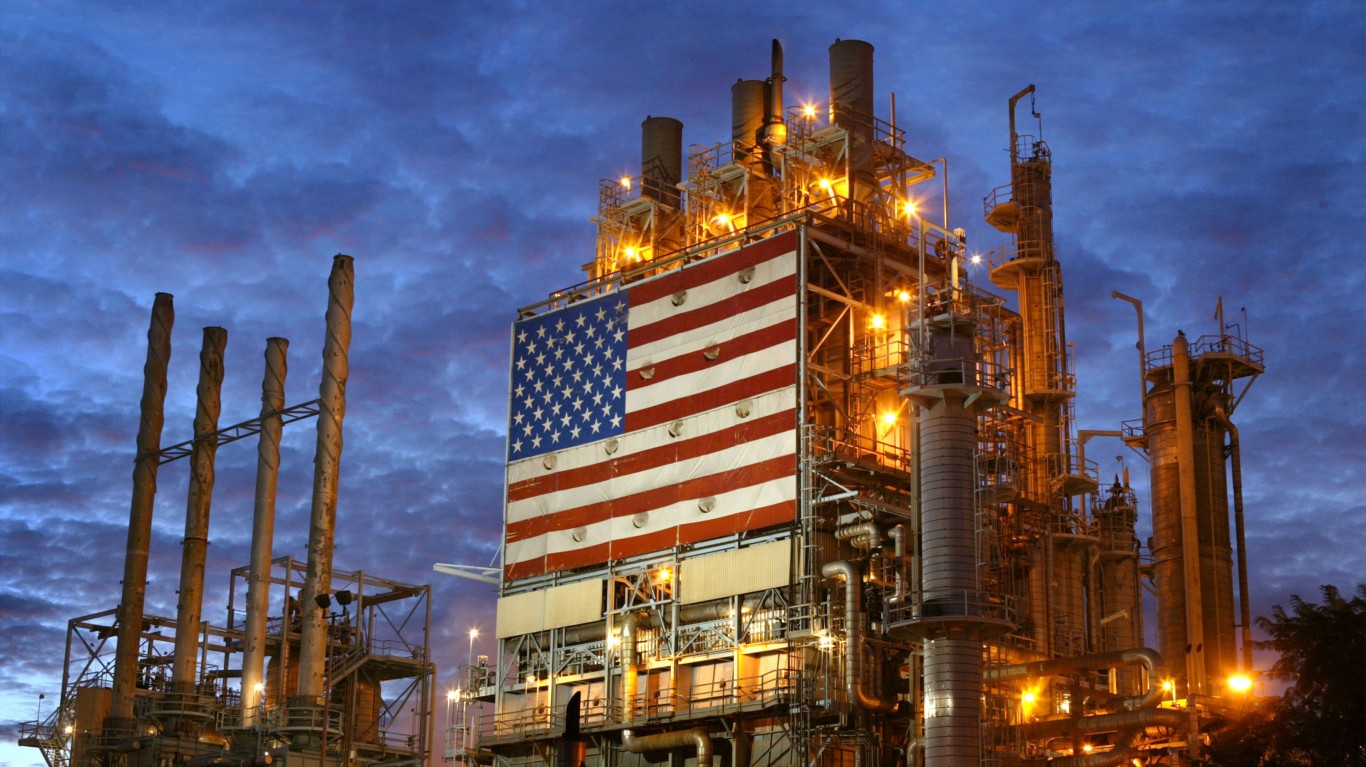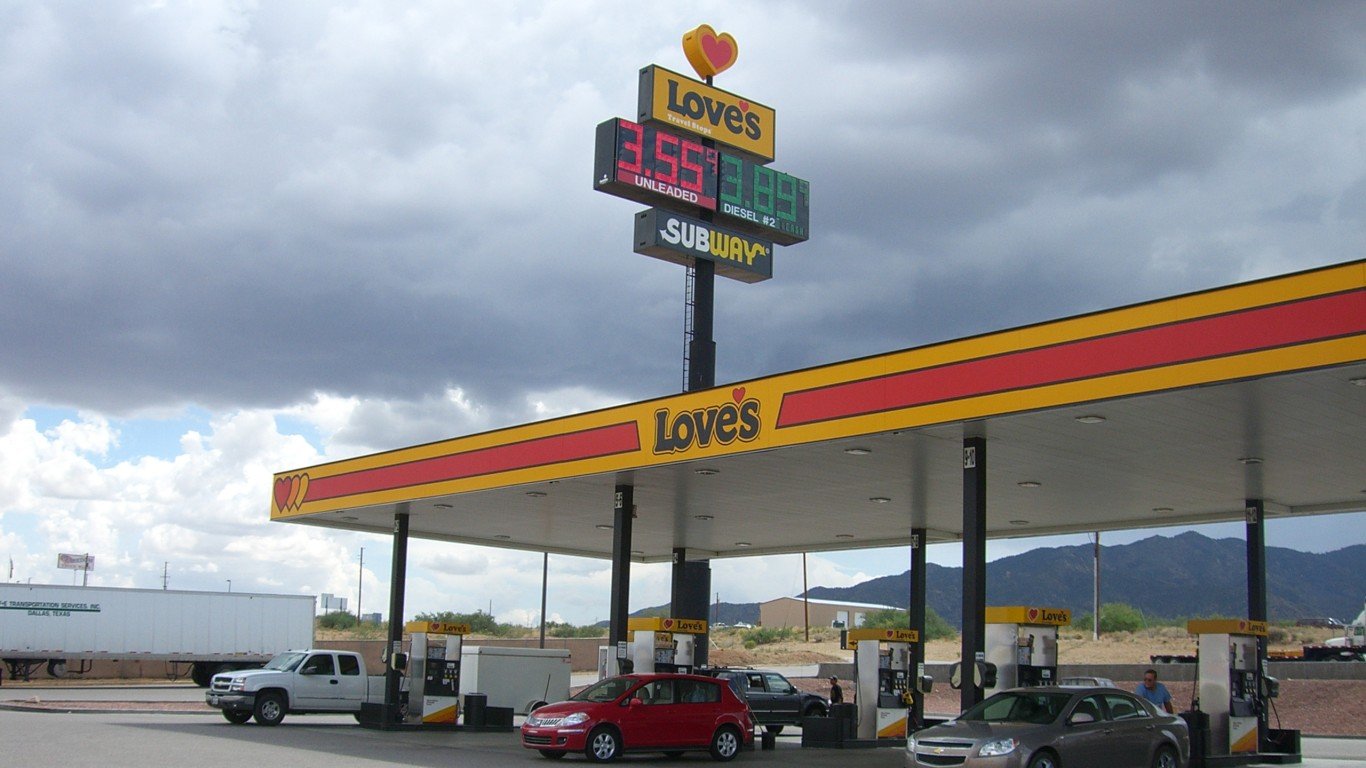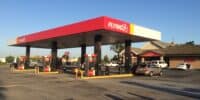 Figuring out how much oil is left in the world and where it is located seems more important than ever, especially considering the political instability in many of the oil-producing countries. 24/7 Wall St. used the most recent public information available to identify the largest oil fields in the world. Those who call for America to end its dependence on foreign oil would be relived to hear the U.S. actually has the world’s largest oil reserve, albeit in oil shale — oil that is in rock form. If prices go high enough, however, and the supply dries out, extracting that oil could become commercially viable.
Figuring out how much oil is left in the world and where it is located seems more important than ever, especially considering the political instability in many of the oil-producing countries. 24/7 Wall St. used the most recent public information available to identify the largest oil fields in the world. Those who call for America to end its dependence on foreign oil would be relived to hear the U.S. actually has the world’s largest oil reserve, albeit in oil shale — oil that is in rock form. If prices go high enough, however, and the supply dries out, extracting that oil could become commercially viable.
Click here to read The Ten Largest Oil Deposits in the World
There are more than 40,000 producing oil fields dotted around the globe, though most are relatively small. Just 100 to 125 giant or supergiant oil fields supply approximately 50% of the world’s oil. A giant oil field is one that contains more than 500 million barrels of recoverable oil. A supergiant fields holds more than 5 billion barrels of recoverable oil. 24/7 Wall St.’s ten largest oil fields in the world are all supergiants.
Interestingly, the largest deposits ever found are not liquid oil at all. They are either an asphalt-like substance called tar or oil sands, or rocks called oil shale. The vast size of these “unconventional” resources is matched only by the vast complexity and cost involved in turning them into liquid petroleum.
Finding new giant and supergiant oil fields brimming with cheap, easy-to-extract oil is surely a historical phenomenon, and the number of new discoveries — of any size — is dwindling. In addition, the largest recent finds are under miles of water and seabed, in some unconventional form or in some inhospitable, usually arctic, climate. The effort required to tap these fields will involve mountains of capital and years of work. No doubt, we need to be prepared to deal with a new reality where oil isn’t as cheap or abundant.
24/7 Wall St. looked at conventional oil fields, like those found in the Middle East, and unconventional oil fields, like oil shale found in the U.S., to come up with a comprehensive list of the largest oil deposits in the world.
These are 24/7 Wall St.’s ten largest oil deposit in the world.
10. Ferdows
> Country: Iran
> Est. Total Resource: 31 billion barrels
> Est. Remaining: 31 billion barrels
> Discovery Date: 2003
Iran’s Ferdows field is located about 50 miles offshore of the country’s Bushehr province. Together with two other fields in the group, Mound and Zagheh, the three are believed to hold 38.5 billion barrels of oil. Ferdows also contains trillions of cubic feet of natural gas, and Iran has signed an agreement with a Malaysian company to develop a natural gas liquefaction plant that could be in operation by 2014. U.S.-led sanctions against Iran have made it difficult for the country to develop its substantial oil reserves and its even more substantial natural gas reserves.
9. Carioca-Sugar Loaf
> Country: Brazil
> Est. Total Resource: 33 billion barrels
> Est. Remaining: 33 billion barrels
> Discovery Date: 2007
Carioca-Sugar Loaf is one of three supergiant discoveries in the Santos Basin offshore of Brazil. At an estimated reservoir size of 33 billion barrels, Carioca-Sugar Loaf is four to five times the size of the other two fields in the basin — Tupi and Jupiter — each of which is believed to hold 5-8 billion barrels of total resource. Brazil’s state-controlled oil company, Petrobras, recently announced that it would spend a staggering $225 billion to develop its Santos Basin reserves — and even that might not be enough. The reservoirs are located in water that is more than 5,000 feet deep and below 25,000 feet or more of sea floor. These figures represent a serious technological challenge. There is no firm data yet on how much of the oil in place could ultimately be recovered.
8. Cantarell
> Country: Mexico
> Est. Total Resource: 35 billion barrels
> Est. Remaining: 4 billion barrels
> Discovery Date: 1976
Cantarell is the largest conventional oil field ever discovered in the western hemisphere. Some attribute the field’s formation to the same asteroid impact that is believed to have caused the extinction of the dinosaurs. Production from Cantarell has fallen dramatically since 2003, when production peaked at 2.1 million barrels/day. The field produced about 500,000 barrels/day at the end of 2010 and is expected to drop below 400,000 barrels/day at the end of this year. Like the number five field on our list, Burgan, Cantarell is not expected to be productive beyond the end of the decade.
7. Kashagan
> Country: Kazakhstan
> Est. Total Resource: 38 billion barrels
> Est. Remaining: 7-9 billion barrels
> Discovery Date: 2000
Kashagan’s discovery in the northern Caspian Sea in 2000 was the largest new conventional field found since Prudhoe Bay in 1968. Development of Kashagan has been delayed by high costs and serious environmental concerns. The original budget called for development costs of $57 billion, but the figure was raised in 2007 to $136 billion because the technical challenges of extracting the oil are significant. First, the reservoir fluid contains a high concentration of a very corrosive compound. Not only does it destroy the equipment, but if allowed to escape, it could devastate the unique ecosystem of the area. Second, the field is located in relatively shallow waters that freeze in the winter. Third, reservoir pressures are very high, which combined with the high levels of toxic gas, creates an expensive safety issue. Production is expected to start in 2012, but this date could well be pushed out again.
6. Bolivar Coastal
> Country: Venezuela
> Est. Total Resource: 44 billion barrels
> Est. Remaining: 14 billion barrels
> Discovery Date: 1917
The Bolivar Coastal field is really a complex of large and small reservoirs around the northern and eastern edges of Venezuela’s Lake Maracaibo. The largest reservoir is Tia Juana, where the total resource was originally put at 15 billion barrels. The entire Maracaibo Basin is thought to hold up to 44 billion recoverable barrels, of which about 30 billion have been extracted through 2006. Of the fields on this list, the Bolivar Coastal has been in production the longest.
5. Burgan
> Country: Kuwait
> Est. Total Resource: 150 billion barrels
> Est. Remaining: 6-25 billion barrels
> Discovery Date: 1938
Burgan, Kuwait’s largest field, resembles the number four field on our list, Ghawar, in its massive size. But unlike Ghawar, it fails the longevity test. Production from Burgan has fallen since the 1991 Gulf War ended, when retreating Iraqi troops set fire to some 700 wells in the field and an estimated 600 million barrels of oil went up in smoke. The field has never recovered and officially entered depletion in late 2005. The fires, coupled with the feckless Kuwaiti government, likely will have the second largest conventional field ever found dry in the next decade or so. Accurate and independently verified numbers on Burgan are not available.
4. Ghawar
> Country: Saudi Arabia
> Est. Total Resource: 162 billion barrels
> Est. Remaining: 11-45 billion barrels
> Discovery Date: 1948
Ghawar is the undisputed heavyweight champion of conventional oil fields. Since beginning production in 1951, the field has given up an astounding 55 billion barrels or so, and still produces at around 5 million barrels/day. Production is enhanced by water-flooding, with about 7 million barrels of seawater pumped into the field every day to force the oil out. The Saudis believe that Ghawar can produce another 125 billion barrels, more than twice its total production after 60 years. There has been no independent verification of any Saudi field since the country fully nationalized its oil resources in 1975, and there is a lot of skepticism over the Saudis’ claims for Ghawar. Still, it could easily rank as the eighth wonder of the world.
3. The Alberta Oil Sands
> Country: Canada
> Est. Total Resource: 173 billion barrels
> Est. Remaining: 169 billion barrels
> Discovery Date: 1980
The Western Canada Sedimentary Basin covers about 540,000 square miles and contains a total of 173 billion barrels of resource in what are called oil sands. Unlike the shales in the American Piceance and Uinta Basins, the Canadian oil sands are already being mined and refined into conventional oil. There are more than 20 active projects in the province of Alberta, most located near Fort McMurray, site of the largest of the three oil sands deposits in the WCSB.
2. The Orinoco Belt
> Country: Venezuela
> Est. Total Resource: 1.3 trillion barrels
> Est. Remaining: 530 billion barrels
> Discovery Date: 1930s
The Orinoco Belt in Venezuela is estimated to hold some 1.3 trillion barrels of oil in place, according to a recent survey by the U.S. Geological Survey. Venezuela now claims it has 297 billion barrels of total reserves, putting it ahead of Saudi Arabia, which is estimated to hold reserves of 265 billion barrels. The Orinoco Belt contains both a heavy sulfurous oil and deposits of tarry oil sands similar to the Canadian variety, though somewhat less viscous. It is nasty stuff, but there is lots of it. In fact, only a bit more than a third of the total is recoverable by today’s technology and economic requirements.
1. The Piceance & Uinta Basins
> Country: USA
> Est. Total Resource: 2.855 trillion barrels
> Est. Remaining: 2.855 trillion barrels
> Discovery Date: 1912
The Piceance and Uinta Basins in western Colorado and eastern Utah are estimated to hold oil shale in place of 1.525 trillion barrels and 1.32 trillion barrels, respectively. The catch is that the stuff is not really oil at all, but rock containing kerogen, a precursor to oil. In a few hundred million years the rock would be converted to flowing oil naturally, if it were left alone. These basins, along with another in southern Wyoming, were added to the U.S. Naval Petroleum and Oil Shale Preserves in 1912, although Native Americans had used the flammable rocks for centuries. The total area covered by the deposits is about 16,000 square miles, an area larger than the states of New Jersey and Connecticut combined. Whether the oil shales are ever developed depends largely on the price of crude and how much environmental impact people are willing endure.
Paul Ausick
Essential Tips for Investing: Sponsored
A financial advisor can help you understand the advantages and disadvantages of investment properties. Finding a qualified financial advisor doesn’t have to be hard. SmartAsset’s free tool matches you with up to three financial advisors who serve your area, and you can interview your advisor matches at no cost to decide which one is right for you. If you’re ready to find an advisor who can help you achieve your financial goals, get started now.
Investing in real estate can diversify your portfolio. But expanding your horizons may add additional costs. If you’re an investor looking to minimize expenses, consider checking out online brokerages. They often offer low investment fees, helping you maximize your profit.
Thank you for reading! Have some feedback for us?
Contact the 24/7 Wall St. editorial team.



